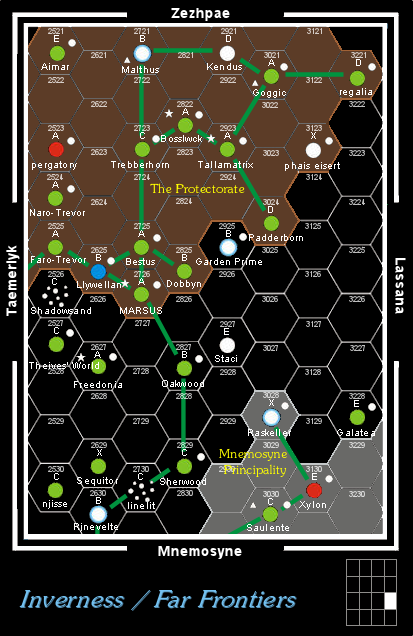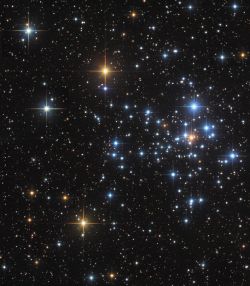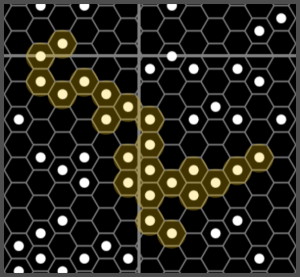Inverness Subsector
| Inverness Subsector | |
|---|---|
 | |
| Sector | Far Frontiers |
| Capital | Bosslwck |
| No. of Stars | 32 |
| Majority Control | The Protectorate - 55% |
| 2nd Control | Non-aligned, human - 35% |
| 3rd Control | Mnemosyne Principality - 10% |
| Map Key | Map Key |
Inverness Subsector is subsector L of Far Frontiers Sector
- It is a region of Balkanized Space.
- It falls within the Zhodani Shadow.
Description (Specifications)[edit]
Inverness Subsector is a region of frantic commercial investment. Whole colonies have been established to expand the labor pool, massive advertising and propaganda campaigns are conducted, and unprecedented exploitation is undertaken – all of which has strained local governments in terms of maintaining law and order.
- The resources of the subsector are being heavily exploited.
Astrographic Features[edit]
The following astrographic data has been determined regarding Inverness Subsector:
- The subsector is an average stellar density region.
- The brightest star is the white giant primary of the Aimar system.
- It does not contain any rift regions.
- No space-time anomalies are known to exist within its borders.
Stellar Distribution[edit]
A basic map showing the distribution and size of stars within Inverness Subsector.
- The color corresponds to the visible color of the star, which links to its spectral classification.
- The size as shown indicates both the physical size of the object and its relative brightness.

(Chart sourced from Traveller Map)
Note that the stars as depicted are representative. Any star, no matter what its size, is a mere speck within the hex it occupies.
- Ordinary main sequence stars can barely be seen from even a hex away.
- Huge, intensely luminous giant stars can be seen from across the subsector and far beyond.
Black Hole[edit]
A black hole object, designated FARF-BH2526, lies within the subsector. It is the remnant of a giant star that went nova millennia ago.
- It has a mass of about 5 solar masses.
- It is the central object of the Shadowsand system.
Borealis Group[edit]
The Borealis Group can be seen as a bright, dense, noticeable grouping of stars in the skies to Spinward-rimward.
- It is a huge cluster of stars centered on the supergiant Theta Borealis.
- It lies around 100 parsecs away.
- It is a distinctive astrographic feature that can be observed from all across Charted Space.
The Borealis Group contains significant amounts of gas and dust that reflects and refracts the light of the stars, giving it an ethereal glow.
Trade Routes[edit]
A number of important trade routes and star clusters lie within the region:
Caractacalla Scatters[edit]
The Caractacalla Scatters (more commonly The Scatters) is a jump-1 main that runs through the center of the subsector.
- It has 22 member systems.
- It forms the heart of The Protectorate.
Alcost Cluster[edit]
The Alcost Cluster is a small cluster of stars that lies within the rimward part of the subsector, crossing the border with Mnemosyne Subsector.
- It is a small, fiercely independent group of worlds that share a common history and heritage.
- Diplomatic and financial agreements between its member worlds facilitate local trade and commerce.

(Chart sourced from Traveller Map)
World Listing[edit]
Comprehensive Second Survey data for all worlds lying within Inverness subsector is available.
- The primary source material for all data is Traveller Map.
- Data is occasionally updated as new information becomes available.
AAB library archives contain expanded data about the following systems:
Verified updated data is constantly sought.
- Scouting missions gathering reliable, verified data can receive substantial payment.
History & Background (Dossier)[edit]
The region has significant populations of Hamadur people – a mixture of Solomani and Vilani with their own distinct culture originating from Shiiki, in Gushemege Sector.
Shiiki was settled by Vilani colonists around -4500, who founded the first cities and began large-scale agriculture despite the world's relatively harsh conditions. They developed a reputation as dour pragmatists who had their own ways of doing things and were less than welcoming to outsiders. Waves of Solomani settled the world from around -2100 onwards, and despite initial hostility from the entrenched Vilani their cultures gradually merged, becoming the distinctive Hamadur.
The growing population on Shiiki caused shortages of essentials such as food and water and severely stressed the worlds infrastructure, a situation exacerbated by the slow collapse of the Ramshackle Empire around them and the resulting decline of interstellar trade. By around -1800, following years of hardship, huge numbers of Hamadur people chose to migrate to spinward, utilizing any ships they could acquire. Their route in their overloaded vessels took them along the Vilani Main, through Vland Sector and across the Vargr-infested wastes of Corridor Sector, and into the empty wildernesses Behind the Claw.
This route to spinward wasn't unknown - explorers had previously crossed this vast region and reported their findings and a few pioneers had even colonized places as far away as Theta Borealis Sector – indeed, later migrants looking for new worlds would follow the same path. One of the largest concentrations of Hamadur people was within what was referred to as the Mnemosyne region of Far Frontiers Sector, which included parts of present Inverness subsector. This area became the focus of further waves of immigrants, who continued to arrive between -1800 and around -1500, when the deepening Long Night and the increasing scarcity of vessels effectively stopped immigration and the Mnemosyne settlements began to develop independently.

(Chart sourced from Traveller Map)
Many of the largest interstellar concerns within the sector are heavily involved in local industry within this frontier region, particularly companies such as Genem, Faraday Engineers, and Qwuim Bosak. Economic considerations on a number of worlds have caused a certain amount of friction between the rival corporations.
Culture[edit]
The subsector lies within the Zhodani Shadow, a region strongly influenced by the society and culture of the Zhodani Consulate.
Polity Listing[edit]
The following polities can be found within this subsector:
Native Sophonts[edit]
The following races (sophont species) are believed to have originated in this area:
- Jessa of Galatea: generally humanoid reptillianoids who live in territorial tribal societies.
- Satha of Galatea: gigantic whale-like aquatic creatures that live in the world's oceans but are able to walk on land.
Demographics[edit]
Significant populations of the following races (sophont species) reside within this area:
- Humaniti (human races)
- Mixed Heritage: widespread across the region.
- Hamadur peoples: largely found within Inverness and Mnemosyne Subsectors.
- Solomani of Terra (major race): many individuals have Solomani ancestry.
- A few worlds have small genetically distinct Solomani populations. These often exist as insular ethnic groups with their own traditions and cultures.
- Vilani of Vland (Major Race): many individuals have Vilani ancestry.
- A few worlds have small genetically distinct Vilani populations. These often exist as insular ethnic groups with their own traditions and cultures.
- Vlazhdumecta of an unknown homeworld (human minor race): widespread across the region.
- Mixed Heritage: widespread across the region.
- Non-Human Races
- Bosaki of Bosak (Minor Race): occasionally encountered across the region.
- Droyne of Eskayloyt (Major Race): occasionally encountered across the region.
- Jessa of Galatea (Minor Race): confined to their homeworld.
- Satha of Galatea (Minor Race): confined to their homeworld.
Linguistic Topography[edit]
The following languages are among the most commonly used within this astrographic region:
- Local Hamadur languages, descended from Old Anglic and Vilani.
- Riftian Anglic, a dialect of one of the two principal languages of the Imperium.
- Vilani, one of the two principal languages of the Imperium.
- Vlazhdumecta: the language of the Vlazhdumecta people. Many dialects exist.
- Local languages descended from Vlazhdumecta. These include Danatic, Kitalla, and Thetric (a trade language).
- Zdetl, the language of the Zhodani and the Zhodani Consulate.
Major Historical Events Timeline[edit]
These are some of the more important historical events that have affected this subsector and the wider region it lies within:
- circa −302,000: to coreward, Ancients arrive at Zhdant (also known as Zhodane) with human stock.
- −6738: the first Psionic Games is held on Zhdant; beginning of the current Zhodani calendar.
- −5823: the Zhodani Consulate is established.
- −5415: the Zhodani unlock the secrets of jump technology, thus becoming a Major Race.
- −5120: the Zhodani contact the Addaxur, a sublight interstellar civilization, in Tienspevnekr Sector.
- −4800: the Zhodani Consulate adopts a policy of absorbing human minor races in adjacent sectors, such as the Vlazhdumecta.
- circa -4200: in distant Gushemege Sector, the Vilani destroy the Loeskalth Empire and absorb their civilization into the mainstream of Vilani culture.
Refugee remnants flee across the Great Rift, becoming the Sky Raiders. - -2957: the Zhodani Consulate attempts to move against the Zhupek Shirkaa; recalling the destruction of the old Vlazhdumecta Colonization Sphere, the Zhupek resist.
- −2000: first Zhodani contact with Vilani traders.
- circa -1800 to -1500: Hamadur peoples migrate from Shiiki, in Gushemege Sector.
- -1776: the Long Night begins.
- −1000: the Zhodani Consulate reaches its present size.
- the year 0: to trailing, the Third Imperium is founded: the Long Night comes to an end.
- 50: the Zhodani make first contact with Imperial traders in Tloql Sector - a region the Imperium calls the Spinward Marches.
- 300-420: the Imperial First Survey charts the subsector.
- 589-604: the First Frontier War.
- 615-620: the Second Frontier War.
- 626: the Driantia Steblenzhtia, or Zhodani Colonnade Province, is founded.
- 800: the Psionic Suppressions begin within the Imperium.
- 941: the Allarton Corporation is formed at Capital to settle and develop the Trelyn Domain.
- 979-986: the Third Frontier War.
- 980: the Trelyn Domain becomes an Imperial client state under Grand Duke Ardesh Varen.
- 995-1065: the Imperial Second Survey charts the subsector.
- 1065: the Second Survey is published.
- 1082-1084: the Fourth Frontier War (the "False War").
- 1107-1110: the Fifth Frontier War.
Subsector Summary[edit]
Inverness, subsector L of Far Frontiers, contains 32 worlds with an estimated combined population of 2 billion, a per capita income of Cr3,916, and a total economy of BCr11,535. These worlds originate an interstellar trade of BCr550 through 25 starports (9 Class A, 6 Class B, 7 Class C, 3 Class D) employing 128,115 people. Driving this interstellar trade are 12 Agricultural (Ag) worlds, one Non-Agricultural (Na) world, five Pre-Agricultural (Pa) worlds, four Pre-Industrial (Pi) worlds, six Rich (Ri) worlds, and one Industrial (In) world. The governments in Inverness maintain four Naval bases and three Scout bases. The average technology level is 8 (with most between 5 and 11). The highest technology level is 13 at Rjnevelte (Far Frontiers 2630).
Inverness, subsector L of Far Frontiers, contains 33 stars and 345 identified planets; 31 monostellar systems, one binary system, no trinary systems, and no systems with four or more stars. 21 of the 32 systems (65%) have native gas giants. There are two Asteroid (As) belts, no Desert (De) worlds, five Garden (Ga) worlds, no Ice-capped (Ic) worlds, three Poor (Po) worlds, four Vacuum (Va) worlds, and one Water (Wa) or Ocean (Oc) world.
Inverness has an estimated population of 2 billion distributed across one High population (Hi) world, three Moderate population (Ph) worlds, 18 Non-industrial (Ni) worlds, four Low population (Lo) worlds, and one Barren (Ba) world. The highest population world is Marsus (Far Frontiers 2726). The population consists primarily of 3 sophont groups including two native sophonts.
| 3 identified sophont populations in Inverness | |
|---|---|
|
The Protectorate[edit]
The Protectorate has jurisdiction over 17 worlds in the subsector with an estimated combined population of 2 billion, a per capita income of Cr3,808, and a total economy of BCr10,825. These worlds originate an interstellar trade of BCr485 through 15 starports (8 Class A, 3 Class B, 1 Class C, 3 Class D) employing 110,800 people. Driving this interstellar trade are seven Agricultural (Ag) worlds, one Non-Agricultural (Na) world, two Pre-Agricultural (Pa) worlds, four Pre-Industrial (Pi) worlds, three Rich (Ri) worlds, and one Industrial (In) world. The governments in The Protectorate maintain three Naval bases and two Scout bases within the subsector. The average technology level is 8 (with most between 5 and 11). The highest technology level is 11 at Pergatory (Far Frontiers 2523), Llywellan (Far Frontiers 2625), Bestus (Far Frontiers 2725), Bosslwck (Far Frontiers 2822), and Goggic (Far Frontiers 3021).
The The Protectorate has an estimated population of 2 billion within the subsector, distributed across one High population (Hi) world, three Moderate population (Ph) worlds, six Non-industrial (Ni) worlds, two Low population (Lo) worlds, and one Barren (Ba) world. The highest population world is Marsus (Far Frontiers 2726). The population consists primarily of 1 sophont group.
Non-Aligned, Human-dominated[edit]
There are 12 Non-Aligned Human-dominated worlds in Inverness with an estimated combined population of 13 million.
Mnemosyne Principality[edit]
The Mnemosyne Principality has jurisdiction over three worlds in the subsector with an estimated combined population of 90 million, a per capita income of Cr7,022, and a total economy of BCr632. These worlds originate an interstellar trade of BCr1 through 1 starports (0 Class A, 0 Class B, 1 Class C, 0 Class D) employing 1,750 people. Driving this interstellar trade are one Agricultural (Ag) world, no Non-Agricultural (Na) worlds, one Pre-Agricultural (Pa) world, no Pre-Industrial (Pi) worlds, one Rich (Ri) world, and no Industrial (In) worlds. The governments in the Mnemosyne Principality maintain one Scout base within the subsector.
The Mnemosyne Principality has an estimated population of 90 million within the subsector, distributed across no High population (Hi) worlds, no Moderate population (Ph) worlds, two Non-industrial (Ni) worlds, no Low population (Lo) worlds, and no Barren (Ba) worlds. The highest population world is Saulente (Far Frontiers 3030). The population consists primarily of 1 sophont group.
References & Contributors (Sources)[edit]
| This article is missing content for one or more detailed sections. Additional details are required to complete the article. You can help the Traveller Wiki by expanding it. |
- Jordan Weisman. Classic Traveller Adventure Class Ships Volume 1 (FASA, 1982), Page 4. (description, Freedonian Condor class SDB) (background for Inverness Subsector)
- J. Andrew Keith. Classic Traveller Fate of the Sky Raiders, (FASA, 1982), various pages. (background for Inverness Subsector)
- Mark Lawrence. Classic Traveller Rescue On Galatea (FASA, 1982), various pages. (background for Inverness Subsector)
- Dale L. Kemper. The Far Frontiers, Ares Magazine, Special Issue 2, (SPI, 1984), page 35. (Inverness Subsector)
- J. Andrew Keith, Marc Miller, John Harshman. Classic Traveller Zhodani, (Game Designers Workshop, 1985), inside front cover. (the Zhodani; sector named and subsector depicted but no further data)
- Dale L. Kemper, Creede Lambard. GURPS Space Space Atlas 3, (Steve Jackson Games, 1990), 64 pages. (various worlds of the subsector)
- Dale L. Kemper. The Far Frontiers, Traveller Chronicle 3, (Sword of the Knight Publications, 1994), page 5. (Inverness Subsector)
- James Kundert. Far Frontiers, Traveller Chronicle 7, (Sword of the Knight Publications, 1994), pages 44-48. (sector background and timeline)
- David L. Pulver. GURPS Traveller: Alien Races 1, (Steve Jackson Games, 1998), pages 5-63. (the Zhodani)
- Don McKinney. Mongoose Traveller: Zhodani, (Mongoose Traveller, 2011), 188 pages. (the Zhodani)
- External Link: RPG Geek, Atlas of the Third Imperium: Far Frontiers Sector, Art Gorski, 2012. (consolidated astrographic references, online resource)







